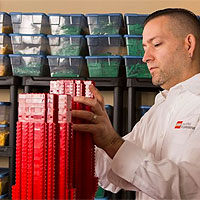“So, are you ready to go inside?” asks Lego artist Adam Reed Tucker, sounding downright Wonka-esque. Having chitchatted with him for 15 minutes in front of his appropriately geometric Prairie-style home in Arlington Heights, my 7-year-old daughter, Josephine, and I are ready to see his stash.
In his upstairs studio, a treasure-trove of plastic bricks greets us, meticulously organized by color in bins stacked seven high along shelves 20 feet across. On the top row, Tucker points out, are test colors—light blues, bright oranges—that Lego never released. (“I have friends at the factory who give me gifts,” says the 44-year-old.)
Scattered about are Lego models of architectural wonders and pop culture touchstones, from the St. Louis arch to a scene from Where the Wild Things Are. Some pieces, such as sprawling lengths of white track from his version of Six Flags Great America’s American Eagle roller coaster, are in sections, midbuild. “Watch your feet,” Tucker calls out as I nearly pull a Godzilla on a chunk of the Colosseum.
What we see is just a fraction of the nine million Legos that fill Tucker’s house and, I assume, test the patience of his wife, Brittny. On the first floor, there are boxes of freshly delivered bricks and stray Legos intermixed with the toys of his 4-year-old son, Jaxson. (When I ask to take a peek at his basement workshop, Tucker confesses that his wife won’t let him because it’s “too messy.”) All told, Tucker’s collection boasts 26,000 sets, including some that even Lego doesn’t have in its archives.
“After I made some money, I thought it would be cool to buy a few sets and get my childhood back,” he says. “It became kind of compulsive.” (Uh, you think so?)
Tucker, whose serious personality matches his intense haircut (a semi-Mohawk that gives him the look of an aging member of a nu-metal band), shakes a sack in front of my daughter. “This bag is worth about $5,000,” he says. It’s full of small blocks made of real gold. He used them to build solar panels on a mini International Space Station, one of the dozen displays he designed for the Museum of Science and Industry’s Brick by Brick exhibit. He gives Josephine a few pieces, which she clenches tightly in her hand.
One of my greatest joys as a parent is the mix of pride and nostalgia I experience while watching my daughters play with Legos. Growing up in the late 1970s and early ’80s (regarded by many as the golden age of Lego), I spent countless hours constructing castles, spaceships, and entire towns with plastic blocks. I actually thought I was quite good at it, too—until my parents entered me in a competition at a local mall, and my crumbling pirate ship was soundly defeated by a replica of the lunar landing.
Unlike her disorderly old man, Josephine follows Lego instructions to a T, and she has already exceeded me as a builder. While visiting the MSI, she was enthralled by Tucker’s amazingly realistic models of everything from the Golden Gate Bridge to the Burj Khalifa in Dubai.
“It’s not Legoland,” Tucker had said, somewhat sheepishly, when I asked if he would let us visit his workspace. He feared Josephine would be bored looking at mounds of Legos that she couldn’t play with. As we sit around Tucker’s desk to learn more about how he became a Lego Certified Professional, he holds up his test model of the turret from Cinderella’s castle. “Do you know what this is?” he asks her. Josephine’s eyes light up. “Of course I do,” she says, instantly riveted. Well played, Lego Man.
For Tucker, Legos are way more than some extreme hobby; they are his full-time job. But he’s not a Lego employee. Rather, he’s a freelance artist who pays a licensing fee to work with the Danish company’s products for his own projects. Museums pay him to display his designs, and he also gets a lot of private commissions. But life as a Lego artist ain’t cheap. Tucker’s bill for the 316,150 pieces he used for the MSI exhibit: $250,000.
Among his fellow certified pros—an elite community of 14 bricklayers he joined in 2007—the former architect is the only one who once designed real buildings. “We all do different things,” he says. “Some do corporate logos. Some do creatures. I couldn’t build a dragon’s head to save my life.”
To become certified, Tucker explains, “you must do something with Lego that has never been done before.” In his case, it was a detailed construction of the old Sears Tower. “I try to capture the essence [of the architecture],” he says. “I use very basic geometric shapes to tell a story.”
Those stories can take the form of political statements, such as the miniature World Trade Center that he brought to a 2006 Lego convention. The towers included cutouts to demonstrate that, despite what happened on 9/11, their design was structurally sound. “People weren’t going up in tall buildings at the time because they thought they were going to collapse,” he recalls. (It was this creation that first got him on Lego’s radar. A few years later, the company asked him to develop its architectural line.) He views his pieces as “sculptural models that have a dual purpose: to shed light on the history of the structure and, at the same time, to push the possibilities of the brick.”
Because of his affiliation with Lego, Tucker is often mistaken for an official ambassador. Parents ask how much it costs to book a birthday party at his house, as if it were an amusement park. If you really want to annoy him, tell him how lucky he is that he gets to play all day. “I don’t look at [Legos] as a toy,” he says. “You look at these bins, they may as well be jars of colored paint.”
But even the über-earnest Tucker can’t fight the pull of nostalgia. Just as we’re getting ready to head home, he proudly walks us through his favorite vintage Lego sets. Josephine is enamored of the 1940s hollow-bodied pieces from Lego’s first line and the packages covered in Greek characters. “They are different, but still kind of the same,” she says of the boxes.
As for me, I hover near the Classic Space sets he’s assembled atop a cabinet. The 1979 Galaxy Explorer and Space Command Center look identical to the ones I built decades ago. I swell with pride. That was one time I actually followed the instructions.




